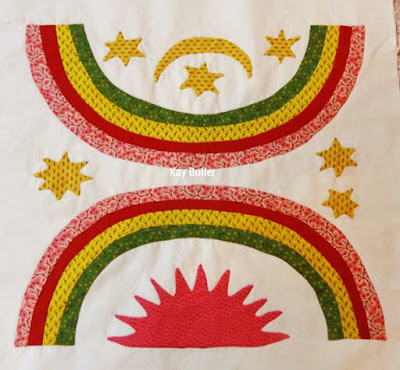A couple of months ago I did a post on the 1859 Tree of Liberty quilt block from Esther Blair Matthews's "Shenandoah Valley Botanical Album Quilt" in the collection of the Virginia Quilt Museum.
http://barbarabrackman.blogspot.com/2017/04/tree-of-liberty.html
Esther, born the year of American Independence 1776, has left us a confusing inscription:
"Tree of Liberty & United States."
Her tree has 35 circles, thought maybe to represent the 33 states in the Union in 1859. Esther lived till 1866 so she saw the admission of the 35th state when Union West Virginia seceded from Confederate Virginia in 1863. But that was nothing for Esther to celebrate. Her family were Virginia Confederates from Rockingham County, near Harrisonburg.
Quilters are currently interpreting the quilt
Here's Doreen Johnson's Tree of Liberty.
The quilt is said to have made for her grandson, Addison Blair Martz who enlisted in the Confederate Virginia Infantry a few days after the first shots at Fort Sumter in April, 1861. According to a family bible:
"Addison B. Martz son of Hiram & Hannah Martz died May the 5th 1863 from the effect of a wound received in the Battle of Chancellorsville May the 3rd 1863."
The first Liberty Tree
The major problem in interpreting Esther's symbolism is the loss of cultural references over the generations. Were we examining the quilt in 1860 we might guess she was referring to the Liberty Tree of 1765 when Britain's Stamp Act enraged Boston's colonists who decorated an old elm tree on with lanterns, posters and effigies of the tax collectors.
Dawn at Collector with a Needle
found a print for each of Esther's circles.
Forty-five lanterns held political symbolism, linking the young rebellion with John Wilkes whose periodical The North Briton had incurred the wrath of the government for criticizing the King in the 45th issue.
No. 45 became a slogan of protest in England and in Boston.
Cream pot with a radical slogan from the
collection of Colonial Williamsburg
Teapot with portrait of John Wilkes.
He was such an icon of liberty that
Americans named their children for him:
John Wilkes Booth, Lincoln's murderer was one.
Whether or not the first Liberty Tree actually had 45 lanterns we will never know, but the idea of a Liberty Tree was copied as an image of rebellion. John Adams noted in his diary in May, 1766:
"Saw for the first time a likely young button-wood tree, lately planted on a triangle made by three roads. The tree is well set, well guarded, and has on it an inscription, ‘The Tree of Liberty, and cursed is he who cuts this tree.' "The slogan "45" was understood by all as a symbol the government should be more responsive to the citizens.
Silversmith Paul Revere's No. 45 Punch Bowl.
45 toast were often offered.
In 1768 in Norwich, Connecticut, according to a local 19th-century history:
"An entertainment was given at Peck's tavern, adjoining Liberty Tree, to celebrate the election of Wilkes to Parliament. The principal citizens, both of town and landing, assembled on this festive occasion. All the furniture of the table, such as plates, bowls, tureens, tumblers and napkins, were marked 'No. 45.' ... The Tree of Liberty was decked with new emblems, among which, and conspicuously surmounting the whole, was a flag emblazoned with 'No. 45, Wilkes & Liberty.' "
Disneyworld has a Liberty Tree with lanterns.
If we were more familiar with the 18th-century concept of a Liberty Tree we might see related meaning in Esther Matthews's quilt, but then again 35 circles are not 45 lanterns. The idea of an elm tree with lights does give us a little insight into her meaning. We can wish she'd left an explanation of her symbolism, but I bet she thought she had.
Read more here:
http://svbotanicalquilt.blogspot.com/p/es_23.html
Tree of Liberty by Pamela Eubanks Winfield
And see what the stitchers who are making blocks from Esther's quilts are up to here:














Very interesting article! It brought to mind...perhaps quilts with any historic value that reflect an opinion that might clash with another person's opinion in our current times....may that quilt be heavily guarded against its untimely destruction!!!!!
ReplyDeleteYour posts are so interesting and thought-provoking. Thank you!
I wonder if there is no overt meaning at all: It is a tree with fruit, and that is what fit in the quilt block and looked pleasing to her.
ReplyDeleteThank you for more information on these interesting blocks.
ReplyDeleteThe pattern of Esther's quilt is still available through the Virginia Quilt Museum, owners of the quilt. All proceeds from Pattern sales benefit the museum.
Thank you Barbara!
Link to paper or digital patterns:
http://svbotanicalquilt.blogspot.com
Right away, I could see a wool penny rug with all those circles. :-) Also, Norwich Ct is right nearby, so that info was quite interesting too. Thanks for all these great insights into history!
ReplyDeleteGreat post.Thanks you.
ReplyDelete